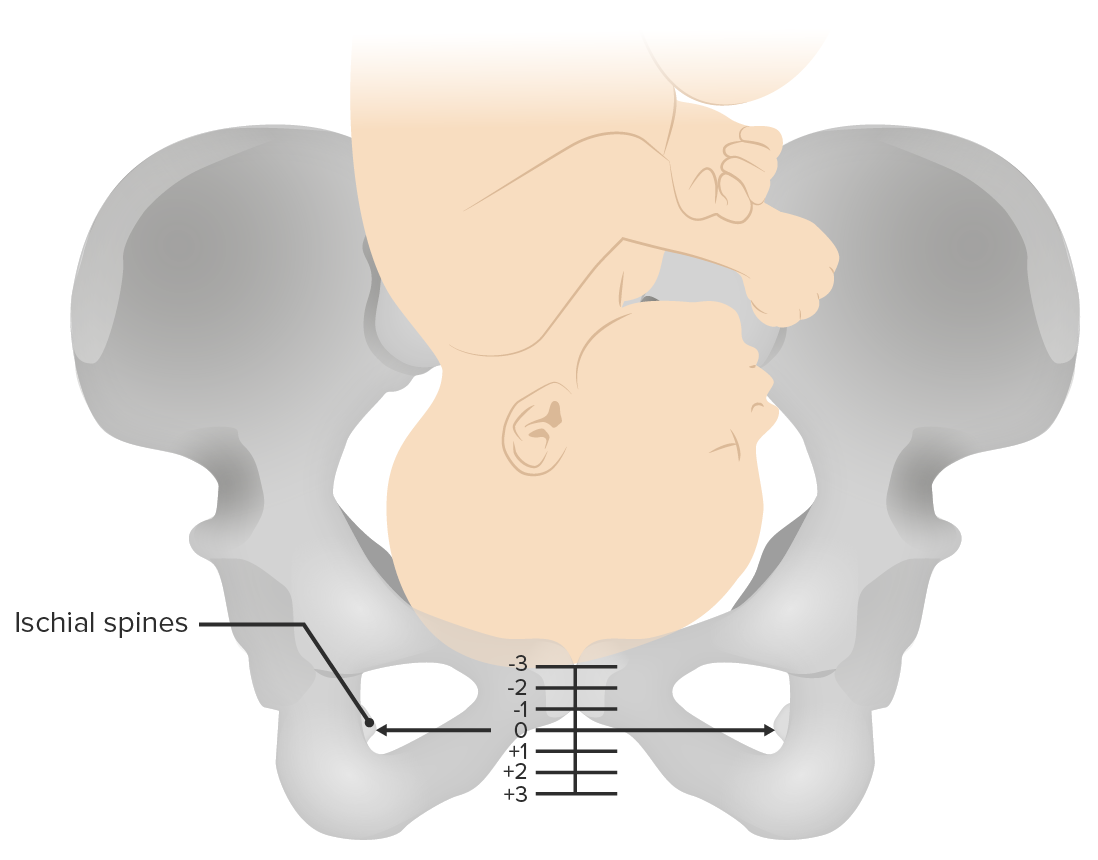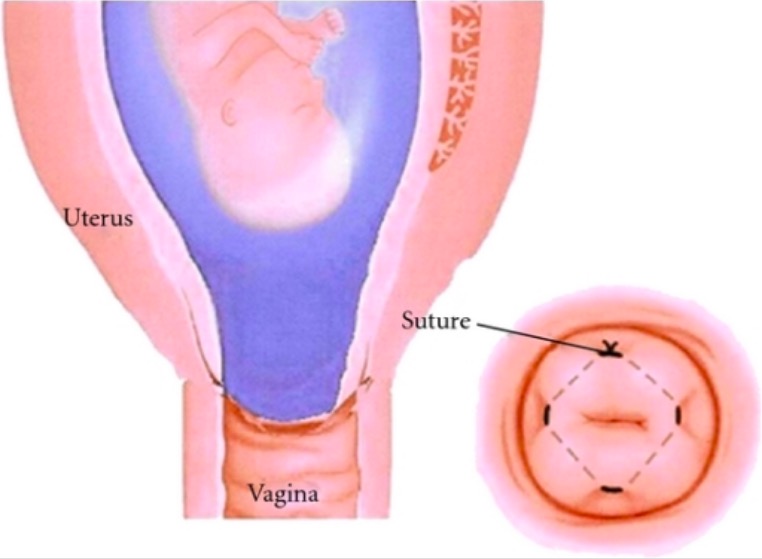Playlist
Show Playlist
Hide Playlist
Stages of Labor
-
Slides StagesofLabor Obstetrics.pdf
-
Download Lecture Overview
00:01 Now as part of normal labor, let's just discuss the stages of labor. 00:06 Stage 1. 00:08 This is the onset of labor until 10 centimeters dilated. 00:12 During stage 1 contractions cause the cervix to change and it causes the fetus to descent into the pelvis. 00:19 Phase 1 can be divided into two phases, the latent phase which is the onset of contractions until 4 centimeters, and the active phase. 00:28 This is from 6 centimeters to 10 centimeters dilated. 00:32 Now when we speak of cervical change, we're talking about cervical dilation, effacement and station. 00:39 Dilation refers to how open the external os of the cervix is. 00:44 This is measured in centimeters and we do this with a digital exam. 00:48 And you can see here from the example, as we go from 1 centimeters to 2 centimeters to 3 centimeters, the external os is opening more. 00:55 When we talk about effacement we talk about how thick the cervix is. 01:01 So when a woman that's not pregnant her cervix feels kind like the tip of your nose. 01:06 It's pretty thick. 01:08 As labor progresses, the cervix starts to thin out and it starts to shorten. 01:13 Now in a primigravida woman, the cervix will thin out more than it dilates. 01:18 The multiparous is the opposite. 01:20 The cervix will usually open a little bit and then starts to thin out. 01:24 And then you see here at 10 centimeters the cervix is fully fully thinned out. 01:29 We call that a 100% effaced. 01:31 Now when we say station, that means we're referring to the presenting part and relationship to ischial spines of the mom. 01:42 You can see at the ischial spines we call that 0 station. 01:47 1 centimeter above is -1 station. 01:49 2 centimeters above is -2. 01:52 On the flip side, 1 centimeter down is +1 station. 01:56 2 centimeters down is +2 station. 01:58 Now we have some parameters that we consider to be normal for the first stage of labor. 02:05 For primiparous woman in latent labor, we expect that to last under 20 hours. 02:11 For a multiparous we expected it to last under 14 hours. 02:14 Now for that active phase of labor for the primiparous woman, we expect her cervix attain 1.2 centimeters per hour. 02:21 And then for the multiparous 1.5 centimeters per hour is the norm. 02:27 Now moving on to stage 2. 02:29 Stage 2 of labor is from 10 centimeters dilated until the delivery of the infant. 02:35 During stage 2, the fetus is entering the pelvis through the cardinal movements of labor which begin in Stage 1 and completed in Stage 2. 02:44 So let's go to cardinal movements of labor. 02:47 First we have engagement. 02:49 This is when the head is starting to come into the pelvis. 02:53 Then we have descent as the head goes down through the pelvis. 02:55 Then we have flexion. 02:58 And basically, that's when the chin is tucked into the chest. 03:01 Internal rotation as the head starts to turn. 03:04 Then we have extension as the head comes underneath the pubic symphysis. 03:09 External rotation, the head is going to return to the same plain that it was in prior to internal rotation. 03:15 And then we have expulsion which is delivery of the fetus. 03:18 Now if you are having a little trouble remembering these steps, I have a little-- let's say metaphor to help you remember. 03:24 We can think it like a wedding. 03:27 First you get engaged. 03:29 Then you descend down the aisle. 03:31 Then you flex your head to pray. 03:33 Then you internally rotate as you turn to your new spouse. 03:36 Then you extend as you lift your head up to further kiss. 03:39 Then you have external rotation as you turn back towards the congregation. 03:43 And then expulsion as you walk down the aisle. 03:46 I hope that little tip, it helps you remember these movements. 03:50 Now for Stage 2, let's consider our norm. 03:53 So for primiparous with an epidural 3 hours. 03:57 A multiparous with an epidural 2 hours. 04:00 Primiparous without an epidural 2 hours. 04:03 And a multiparous without an epidural 1 hour. 04:06 So these are our norms that we expect for how long it takes for mom pushing in Stage 2 of labor. 04:13 Now Stage 3 of labor. 04:15 This is from the delivery of the infant until delivery of the placenta. 04:18 To deliver the placenta, we have gentle downward tractional umbilical cord, while the other hand puts gentle traction on the uterus. 04:27 In the normal setting we expect the placenta to deliver within 30 minutes.
About the Lecture
The lecture Stages of Labor by Veronica Gillispie, MD, MAS, FACOG is from the course Intrapartum Care. It contains the following chapters:
- Stages of Normal Labor
- Stage 2 – Normal Labor
- Stage 3 – Normal Labor
Included Quiz Questions
Which of the following best describes stage 1 of labor?
- From the onset of contractions until the cervix is 10 cm dilated
- From the onset of contractions until the cervix is 4 cm dilated
- From when the cervix is 4cm dilated until it is completely dilated at 10cm
- From the onset of contractions until delivery of the fetus
- From the onset of contractions until the delivery of the placenta
Which of the following is NOT monitored by digital exam during labor?
- Cervical color
- Cervical dilation
- Cervical effacement
- Cervical position (i.e., anterior, midline, or posterior)
- Fetal station in the pelvis
Which of the following terms is used to describe the size of the opening of the external os of the cervix?
- Cervical dilation
- Cervical effacement
- Cervical station
- Cervical texture
- Cervical position
What term is used to describe the measurement of the thickness of the cervix?
- Cervical effacement
- Cervical thickness
- Cervical dilation
- Cervical station
- Cervical position
When determining the station of the fetus, the presenting part of the fetus is measured in relation to what structure?
- The maternal ischial spines
- The maternal pubic symphysis
- The maternal vaginal introitus
- The maternal external cervical os
- The maternal internal cervical os
When does the active phase of the first stage of labor start?
- When cervical dilation is 6 cm
- When contractions occur at regular intervals every 5 to 10 minutes
- When the membranes are ruptured
- When contractions occur at regular intervals every 2 to 5 minutes
- When cervical dilation is 2 cm
Up to how long is the latent phase expected to last in the NORMAL progression of labor for a primiparous woman?
- Up to 20 hours
- Up to 27 hours
- Up to 14 hours
- Up to 29 hours
- Up to 4 hours
Which of the following best describes stage 2 of labor?
- From when the cervical dilation is 10 cm until the infant is delivered
- From when the cervical dilation is 4 cm until completion of dilation
- From when the infant is delivered until the delivery of the placenta
- From when the cervix is 100% effaced until the infant is delivered
- From when the station is at 0 cm until the infant is delivered
How long is a NORMAL third stage of labor allowed to last?
- Up to 30 minutes
- Up to 30 seconds
- Up to 1 hour
- Up to 20 minutes
- Up to 24 hours
Which of the following answers is the correct sequence of cardinal movements of labor?
- Engagement, descent, flexion, internal rotation, extension, external rotation, expulsion
- Engagement, flexion, external rotation, extension, internal rotation, expulsion
- Engagement, extension, internal rotation, flexion, external rotation, expulsion
- Engagement, extension, external rotation, flexion, internal rotation, expulsion
- Engagement, internal rotation, flexion, extension, external rotation, expulsion
A G3P2 woman at 39 weeks gestation with a history of two prior normal spontaneous vaginal deliveries presents with painful contractions. On digital exam, her cervix is 5 cm dilated, 60% effaced, and at -2 station. How fast should you expect her cervical dilation to expand during active labor?
- About 1.5 cm every 1 hr
- About 1.2 cm every 1 hr
- About 1.5 cm every 4 hrs
- About 1.2 cm every 2 hrs
- About 1.5 cm every 2 hrs
Customer reviews
4,5 of 5 stars
| 5 Stars |
|
3 |
| 4 Stars |
|
0 |
| 3 Stars |
|
1 |
| 2 Stars |
|
0 |
| 1 Star |
|
0 |
I liked it due to the fact that it was easy to understand and nice to watch.
Stage one is divided into two phases latent until 4 cm dilated and active phase from 6 cm - 10 cm. what about from 4cm - 6cm? under which phase does it fall? Most of the resources state latent phase is until 6 cm dilated.
Like it very much! was a great lecture! thank you very much!
Definitely watching it again, loved the lecture, pace and was able to focus since the material is very clear. Nothing distracts me.





